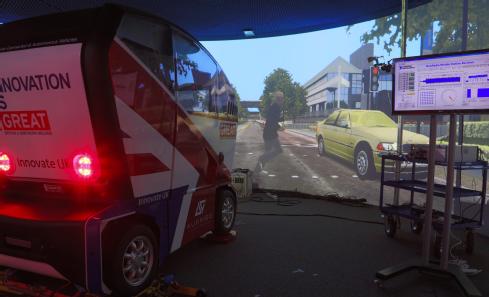WMG News - Latest news from WMG
Researchers set an autonomous vehicle communications record using 5G - a movie’s worth of data sent in seconds
Researchers in WMG at the University of Warwick have set a new 5G communications speed record to a “Level 4” low speed autonomous vehicle in the pioneer 28 GHz millimetre wave band. They hit 2.867 gigabits per second in over-the-air transmissions, which is nearly 40 times faster than current fixed line broadband speeds. It is equivalent to sending a detailed satellite navigation map of the United Kingdom within a single second, or the full contents of a high definition blockbuster film in less than 10 seconds.
However this crucial wireless communications technology is not just being designed to deliver HD content to in-car entertainment systems, but it will allow autonomous vehicles to rapidly share large quantities of data with each other and with traffic management systems. This will include precise 3D road maps created by LiDAR (like radar but it uses laser light instead of radio waves), high definition video images of the vehicles surroundings, and traffic information.
WMG’s research team of Dr Matthew Higgins, Associate Professor, and Dr Erik Kampert, Senior Research Fellow, used their new 5G mmWave test facility (one of the most advanced in Europe) to set the new 5G mmWave band communications speed record. Working with an autonomous Pod built by RDM, a Coventry-based manufacturer of Level 4 low speed autonomous vehicles, the team optimised antenna placement both inside the pod, and on roadside infrastructure, such as a traffic light.
WMG’s Dr Matthew Higgins said:
“These controlled trials are critical to better understand the capabilities of 5G in millimetre wave bands, and how infrastructure providers and vehicle manufacturers must carefully plan and deploy their 5G service and application rollout over the next few years. This project, which includes real-world 5G mmWave trials on the University of Warwick’s campus, will also attempt to examine how the dynamics of both the vehicle and the environment affect performance between infrastructure and connected and autonomous vehicles.”
Bob Slorach, CTO of UK based Wireless Infrastructure Group, which provides support to the project, added that
“This is an exciting step towards to the realisation and deployment of future 5G applications, like connected and autonomous vehicles, which will be enabled by fibre connected wireless infrastructure that supports high data rates and ultra-low latency mobile broadband.“
The WMG research project is supported by Wireless Infrastructure Group (WIG), National Instruments (NI), and HVM Catapult.
ENDS
26 SEPTEMBER 2018
About WMG’s advanced 5G mmWave test facility
WMG’s advanced 5G mmWave test facility includes some of Europe’s most advanced 5G mmWave testing equipment. This has been provided by a £250,000 WMG Centre HVM Catapult award for facilities and people, alongside an equipment collaboration with National Instruments (NI) for their mmWave technology platform. WMG’s Intelligent Vehicles research team are using the facility with a range of partners and industrial collaborators on connectivity, verification & validation, and the understanding and optimisation of user/customer interaction to accelerate product introduction for Connected and Autonomous Vehicles (CAV).
About WMG, University of Warwick
WMG is a world leading research and education group and an academic department of the University of Warwick, established by Professor Lord Kumar Bhattacharyya in 1980 in order to reinvigorate UK manufacturing through the application of cutting edge research and effective knowledge transfer.
WMG has pioneered an international model for working with industry, commerce and public sectors and holds a unique position between academia and industry. The Group’s strength is to provide companies with the opportunity to gain a competitive edge by understanding a company’s strategy and working in partnership with them to create, through multidisciplinary research, ground-breaking products, processes and services.
Every year WMG provides education and training to schoolchildren through to senior executives. There is a growing part-time undergraduate programme for apprentices, as well as full-time undergraduates. The postgraduate programmes have over 2,000 students, in the UK and through centres in China, India, Thailand, South Africa and Malaysia.
For more information visit www.wmg.warwick.ac.uk
About Wireless Infrastructure Group (WIG)
WIG is an independent wireless infrastructure operator headquartered in Edinburgh. Established in 2007 and backed by 3i Infrastructure plc WIG is one of the UK’s larger challenger infrastructure companies. The Company builds fibre-based networks to improve mobile coverage in large buildings, stadiums and on city streets, together with communication towers (masts) in rural and suburban areas. The company is fully independent of any network operator and invests in higher capacity ‘neutral-host’ infrastructure that is made available to all mobile and wireless networks to use on an open and shared basis. Support of this project is part of WIG’s wider investment activity targeted at enabling connectivity along UK transport routes. WIG is also the largest private investor in Midlands Future Mobility (the UK’s largest real-world CAV test bed) and a leading bidder to enable mobile services on the London Underground.
About National Instruments (NI)
For more than 40 years, NI (ni.com) has developed high-performance automated test and automated measurement systems to help you solve your engineering challenges now and into the future. Our open, software-defined platform uses modular hardware and an expansive ecosystem to help you turn powerful possibilities into real solutions.
FOR MORE INFORMATION PLEASE CONTACT:
Lisa Barwick, Head of Marketing and Communications, WMG, University of Warwick
Tel: 024 76 524721 or 07824 540845
E-mail L.Barwick@warwick.ac.uk
OR
Alice Scott, Media Relations Manager, University of Warwick
Tel: 02476 574255 or 07920 531221
E-mail alice.j.scott@warwick.ac.uk
